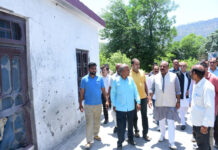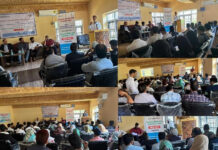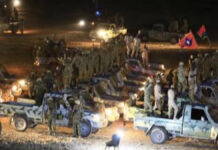
DOGRA HERALD BUREAU
New Delhi, Nov 21
The National Disaster Management Authority (NDMA) on Tuesday said that the most ‘focused effort’ of rescuers working at the Silkyara tunnel collapse site is the ‘horizontal drilling’ through the Auger machine to evacuate the 41 workers trapped for 10 days in the 2-km-built portion of the under-construction structure.
Member NDMA, Lt Gen (Retd) Syed Ata Hasnain, said that the efforts to rescue the trapped men is underway from five sides but the best possible method is the horizontal drilling from the Silkyara end of the tunnel.
As per the rescue plan, the 900 mm pipes will be pushed in using the horizontal drilling equipment to create an escape for the workers.
“The most focused effort is horizontal drilling through the Auger machine, which is being explored. It started working on November 16 and it has reached 21-22 metres,” he said in a press briefing.
The collapse occurred on November 12 during the construction of a tunnel from Silkyara to Barkot, trapping 41 labourers due to a muck fall in a 60-metre stretch on the Silkyara side of the tunnel.
The NDMA official said that on November 12, the tunnel caved in, trapping the 41 workers inside the 2 km-long portion of the tunnel. He said that the other Barkot side of the tunnel was already closed, as work on that side had not yet started.
“So that end is also closed. As a result, the workers are trapped between the cave-in and the other end (the Barkot side), which is yet to be accessed,” Hasnain said.
“At present, different agencies, NDRF, ITBP, Army engineers, SDRF, fire and emergency services, Border Roads Organisation and other technical agencies of the Central government are working there,” he said.
The NDMA member said that when a tunnel rescue takes place, it is a very serious and challenging effort.
“Around 3-4 international experts have also come to the site. The government has made sure that wherever we have knowledge of experts, those experts have flown in and are available for advice,” he said.
Meanwhile, he said that a top attack, vertical drilling, to pull out the trapped labourers is also being explored. “For that, the Border Road Organisation has made a road and equipments are being taken there,” Hasnain said, adding that the priority of the government is ‘lifesaving’.
The official went on to add that a 4-inch pipe was available from the beginning, through which rations were made available for the survival of the trapped men.
Notably, the workers were provided food items and medicines through a 4-inch compressor pipeline until Monday, before the rescuers achieved a breakthrough by laying an alternative 6-inch-wide lifeline pipe through which hot meals like Khichdi in cylindrical plastic bottles were sent to labourers for the first time later.
The NDMA official said that a few families of the trapped men hailing from different states have been moved and accommodated in the local hotels near the site.
“Among the trapped labourers, two belong from Uttarakhand and Assam each, one from Himachal, eight from Uttar Pradesh, five each from Bihar and Odisha, three from West Bengal, and the most from Jharkhand (15),” he said, adding that most of the state governments have sent their representatives at the site.
He also said that the families are also being allowed to talk to their trapped loved ones through the 4-inch compressed pipe.
“The more families talk to the people, the better will be the morale and the better will be the survivability,” he said.
Moreover, the NDMA member said that another horizontal drilling is being tried from Barkot’s side. “But it is time-consuming,” he said, adding that the already drilled 22 metres against the 60-65 metres through Auger machine, which has been recommenced, is the best possible method to rescue the labourers.
Earlier in the day, the International Tunnelling and Underground Space Association president Arnold Dix, who has been roped in as part of the ongoing rescue efforts at the Uttarkashi tunnel collapse site, said that the 900 mm pipes pushing is the fastest means to get the men out.
“I think the team here have done a wonderful job. It’s just fantastic. The 900 pipeline is one of the options. The 900 pipe which is there, which I’ve seen, and I’m going to go have another look at this morning. It’s by far the best and fastest means to get the men, but it has its technical difficulties and that’s why we’re doing multiple rescue missions,” Dix said.
Earlier today, rescuers managed to insert an endoscopy camera into the tunnel and first visuals captured showed the 41 workers had ample space inside the tunnel for them to move about.
Visuals of workers trapped inside for the past 10 days emerged on Tuesday morning, has given new hope to worried relatives, some of whom are camping outside the site of the collapsed tunnel structure.

























